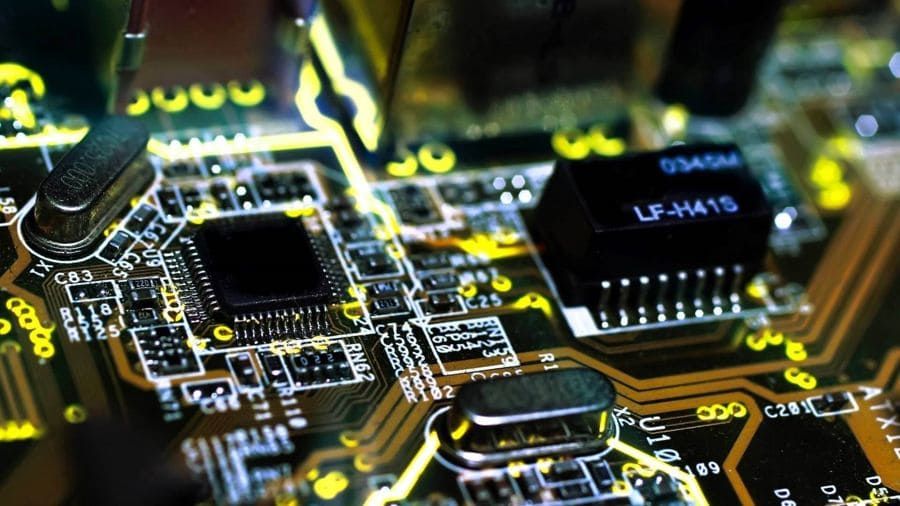A Brief History of Automotive Electronics Technology

The development of automotive electronics has changed the game for car technology, turning an automobile from a pure mechanical machine into a computer-controlled vehicle. In the last century, electronics have transformed vehicle functionality, safety, efficiency and connectivity. This article follows the evolution of automotive electronics from early electrical systems to the modern ecosystem of smart vehicles with connectivity, autonomous driving technology, and beyond, as well as looks at what the future holds for the next generation of vehicles.
1. Basic Electrical Systems (1900s–1950s)
The early cars were mechanical things, with hand cranks for starting and magnetos for ignition. The origin of automotive electronics began in the early 20th century with the advent of the electric car. One of the most important early innovations was the electric starter, introduced by Cadillac in 1912, which eliminated the dangerous hand cranking. By around the same era, electric lighting systems would supplant acetylene lamps and at night, while improving visibility, safety also would be improved.
No further progress was made until the 1930s and 40s, when other innovations appeared, such as the car radio in 1930 (Motorola), providing entertainment in the vehicle. Buick debuted the first turn signals in 1939, before that, drivers used their hands to signal which way they were about to turn. Voltage regulators where also introduced at this time to guarantee better charge for the battery and protection against overcharging.
With the 1950s, the advent of vacuum tubes was replaced by transistorization, and with it more reliable discharges. Another significant development was the first electronic fuel injection (EFI) system made by Bosch in 1951; the technology took several decades before becoming standard in production cars.
2. The Revolution in Microprocessing (1960s 1980s)
The 1960s were the dawn of a new age as microelectronics began to find their place in cars. The alternators replaced DC generators, which were more efficient in generating power for new and more elaborate electrical systems. Electronic ignition systems also started replacing mechanical distributors, adding to the reliability and performance of the engine.
By the 1970s emissions became tighter and tighter until the auto manufacturers were forced into the age of electronic engine control units (ECUs) so that they could control fuel delivery and ignition timing more precisely. Digital dashboard displays first appeared in high-end concept cars and luxury lines, such as the mid-1970s Aston Martin Lagonda, in which LED-based digital instruments were incorporated.
By the 1980s microprocessor-based fuel management systems allowed for improved management of power and emissions while providing better fuel economy. Safety also advanced by leaps and bounds when Anti-lock Braking Systems were first developed by Mercedes-Benz and Bosch in 1978. Important advances also included the debut of on-board diagnostics, or OBD-I, which enabled mechanics to diagnose engine problems more quickly.
3. The Era of Computing and Telecommunications (1990s–2000s)
The 1990s also brought rapid gains in digital technology which begat smarter and more connected vehicles. The introduction of electronic stability control (ESC) by Mercedes-Benz and BMW in the mid-1990s dramatically lowered the rate of accidents involving skidding. Airbag technology also advanced, relying on more sophisticated sensors to determine when best to deploy in a crash.
With the introduction of hybrid-powered vehicles in the late 90s and early 2000s, this trend advanced even further. The initial Toyota Prius, available from 1997, contained some very advanced power electronics, including regenerative braking to spare regenerative energy. But Electronic Stability Programs and advanced traction control slowly became standard with the 2000s and magnitude then improved vehicle safety.
4. Modern Age(2010s–Present)
The automotive electronics world has experienced rapid change and explosion during the last ten years influenced by advancements in AI, connectivity, and EV technology. In many cars today, advanced driver-assistance systems (ADAS), such as adaptive cruise control, lane-keeping assist and automatic emergency braking, are standard, helping to keep the road safer for drivers and all other users.
From electric starters and rudimentary ignition systems to AI-powered self-driving cars, the history of automotive electronics is a rich one. With every technological jump, drivers and riders experience a quantum leap in safety, efficiency and how they use the roads. And as we head into a future of Internet of Things (IoT) connected and autonomous vehicles, electronics will be a key enabler for automotive innovation, helping us to envisage and realize smarter, safer, and more sustainable transportation.
 Disclaimer:
Disclaimer:
The content provided on our blog site traverses numerous categories, offering readers valuable and practical information. Readers can use the editorial team’s research and data to gain more insights into their topics of interest. However, they are requested not to treat the articles as conclusive. The website team cannot be held responsible for differences in data or inaccuracies found across other platforms. Please also note that the site might also miss out on various schemes and offers available that the readers may find more beneficial than the ones we cover.
Related Websites
-
 Finance
FinanceBenefits of Medicare Plan F
This comprehensive coverage includes the rare benefit of guaranteed coverage which gives recipients peace of mind that they will be covered regardless of their health. It's a kind of Medigap plan, which means it's designed to fill gaps in coverage under Original Medicare (Part A and Part B) to help pay out-of-pocket expenses like deductibles, co-payments and coinsurance. Medicare Plan F is for many seniors the gold-standard plan, providing them with broad coverage of services and fewer surprises when it comes to paying for health care.Almost anything is covered under Medicare Plan F. Established at the same time as Plan G, Plan F also differs from the rest of the Medigap plans by covering the entire Medicare Part A and Part B deductibles, coinsurance and co-payments. This means beneficiaries are not required to pay for these out of pocket, which can be especially helpful for those who need medical or hospital care on a regular basis. Plan F also covers Part B excess charges that some healthcare providers can charge above what Medicare agrees to pay.On this basis, the Minimal Essential Coverage, (MEC) protects the beneficiaries from unforeseen healthcare costs and therefore is considered to be valuable.Medicare Plan F covers coinsurance for skilled nursing facility care, and this is one of the best features about Medicare Plan F. After a hospital stay, many seniors require some additional care in a skilled nursing facility, and Plan F covers the coinsurance cost for up to 100 days, per benefit period. This is a potentially massive win for people recovering from surgery, or grappling with chronic conditions — it takes away the significant cost burden of receiving care for a long time. Plan F also covers emergency care you get while traveling outside the country, which all Medigap plans don't. This benefit gives piece of mind to international travelers (including seniors) that they have coverage if a medicalemergency occurs outside of the United States.PlanF also helps beneficiariesbudget for their healthcare. With the vast majority of out-of-pocket expenses-paid for,seniors will have a clearer view of their healthcare costs, making budgeting simpler. That predictability matters especially to people with fixed incomes, because it's one less thing for them to have to worry about if they're stuck with an unpredictable bill for a medical visit. Moreover, Plan F also offers the same thing as Plan N, the ability for beneficiaries to go to any healthcare provider that accepts Medicare, which means they can choose their doctors and specialists without worrying about being in network.Such a free choice is a major benefit for people who prefer continuity in healthcare, or who have established ties with particular providers.Medicare Plan F, which offers several benefits, is not available to new Medicare beneficiaries who entered the program on or after Jan. 1, 2020. This included an amendment that would limit the amounts that cover the Part B deductible in Medicare plans, under the auspices of getting the Medicare costs under control; this change would be enacted in 2015 with the passage of the Medicare Access and CHIP Reauthorization Act (MACRA). But, people who became eligible for Medicare prior to this date are still able to enroll in Plan F, which makes PlanF a solution for a wide range of current beneficiaries.Overall, Medicare Plan F is one such Medigap plan known for its extensive coverage, financial stability,and flexibility in healthcare choices. With its coverage capabilities for virtually all out-of-pocket costs not covered by Original Medicare, it is an attractiveoption for seniors looking to reduce their healthcare costs. It remains an effective financial tool for addressing healthcare as part of retirement planning. By far the most popular choice among seniors seeking Medicare Supplement Insurance, Plan F is among the most sought-after policy tiers. -
 Health & Wellness
Health & WellnessEtiology of Hives
The medical name for hives is urticaria, and they are a commonly occurring skin condition that involves sudden, itchy, red and swollen areas of skin, know as welts, on the skin. They can also vary in size and shape and often arise and subside multiple times in a short period. Hives are usually not life threatening, but can be painful and distressing. Once you know what is triggering it or treated the underlying causes of the hives, your hives will go away. Life history and co-morbidities have a debilitating impact affecting transition to adulthood, and the hive is one of them. Here are the reasons why you encounter the hives.1.Allergic ReactionsFirst and foremost, allergic reactions are among themost widespread causes of hives. When the body reacts to an allergen, the immune system is hyperactive and release histamine and other chemicals in the blood. This results in blood vessel dilation and the swelling and itchiness characteristic of hives. Several common allergens which may lead to the hives include nuts, eggs and dairy products. And if you are stung and bitten by some insects, you may also have the chance to get hives. Even exposure to latex or certain chemicals has made me break out into hives in some cases.2.Physical StimuliThese typesof hives occur for example might occur after physical stimulation of the skin. There are many sub-typeswithin each category which may have a different trigger. Dermatographism, or “skin writing,” is an example of this phenomenon in which, when the skin is lightly scratched or rubbed, raised welts appear.The cold hives can be obtained by the exposure to the low temperature, while the solar hives results from the exposure to the sunlight. Heat hives which is caused by heat, cholinergic hives which is caused by the increase in body temperature such as exercise or taking showers, are other common physical hives. What is more, hives can be caused by these physical triggers that make the mast cells in the skin histamine-producing cells.3.InfectionsOne more common reason that causes the hives is the infection by virus or bacteria. Other viral infections — like the regular flu and hepatitis — can stir the immune response so much that hives result. The hives also can happen during a viral illness, particularly from the common cold, and can occur when you are infected by bacteria, especially because of the streptococcus or staphylococcus. And hives can be caused by all sorts of conditions, including infections from parasites.Infections are thought to elicit hives through the same process, although the exact mechanism is not fully understood.4.Systemic DiseasesHives may also be thesymptom of an underlying systemic disease. Chronic urticaria is often associated with autoimmune diseases such as lupus, rheumatoid arthritis and thyroid disease. Increased inflammation and rushing histamine are generated under these circumstances, causing the immune system to inaccurately attack the body’s own tissue. Certain cancers can also be behind hives, as part of the immune response the body launches to fight the malignancy, particularly lymphomas and leukemias. In some cases, hives can be a sign of an underlying endocrine disorder, such as diabetes or adrenal insufficiency.All in all, hives can have many different causes, with both allergic and nonallergenic sources behind the mechanisms that lead to this condition. The cause of what that will be individualized for what kind, however, will always have a foundation to the treatment and management of the eczema that person has. In several instances, recognizing and avoiding the trigger can greatly lessen the frequency and intensity of outbreaks. But chronic urticaria may require a more complex treatment plan that could involve antihistaminesor other medications to help manage symptoms. With further research, revealing the mechanisms behind hives, new and more targeted treatments are likely to come, and that driveshope who have to deal with thisproblem. -
 Travel
TravelHelpful Tips for an Easy Air Travel
While air travel can be exciting, it isn't without stress. From navigating busy airports to working with flight delays, it can be a lot to handle. But with some preparation and a change of outlook, you can find ways to make your air travel experience easier and more pleasant. Here are a few tips to fly without any stress.1.Plan and Prepare in AdvanceOne of the best methods of preparing for travel stress is to plan ahead. Make reservations for your airline tickets ahead of time so you can find the best available seats and rates. Check your airline’s baggage policies so you don’t have any surprises at the airport. When traveling internationally, get your passport up to date and learn the visa rules. Be sure to make a list in advance of things you will need, such as travel documents, medication and chargers, so you avoid a last-minute meltdown.2.Pack SmartPacking well can help you save time and headaches. To maximize luggage space and ensure organization, pack with packing cubes. Pack the packages with you if you can, because this can avoid some checked-bag fees and the adventure of luggage loss. Do remember to put clothes, toiletries and any other necessary medicines into your bags in case of your plane is delayed. If you’ll be doing shopping during your trip, save room for souvenirs.3.Arrive EarlyAllowing more time than needed when arriving at the airport will go a long way in decreasing stress. Try to get there at least two hours ahead of a domestic flight and three ahead of an international one. That gives you plenty of time to check in, clear security and deal with any surprises. Take this additional time to kick back, get a snack or walk around the airport.4.Stay OrganizedStore all your travel documents like your boarding pass, your passport, your ID in one easily accessible place. Use a travel wallet, or a digital app, for important information. Having everything organized will help you avoid a fumble through your bag at security or the boarding gate.5.Dress ComfortablyDress your flight in something comfortable, especially if you’re on a long journey. Instead, layersare best, as temperatures do fluctuate on planes. Abjure belts or unnecessary jewelry, to assist security screening in becoming a more efficient process.6.Stay Hydrated and NourishedAvionics cabins can be dehydrating, so you should drink lots of water before and during your flight. Take an empty reusable water bottle for filling up after you clear security. Bring healthy snacks, such as nuts, fruit or granola bars to fuel your energy level, especially if you have dietary restrictions or prefer not to bank on airline food.7.Entertain YourselfLong flights can be monotonous, come armed with entertainment. Download movies, TV shows, podcasts or e-books to your devices. You can amplify your in-flight entertainment and block cabin noise with noise-canceling headphones. If you want to do something offline, bring along a book, journal or puzzle book.8.Engage in RelaxationTechniquesFor nervous flyers or those who typically feel some stress during the flight, relaxation techniques, including deep breathing, meditation or listening to relaxing music, may also help. These practices enable you to remain calm and collected throughout, thus making the flight more pleasant.9.Be Kind and PatientTravel is stressful for all, so keeping a positive attitude and being kind to airline employees and other passengers will take you far. The interaction can become more pleasant for all — so easy to do with a smile or a kind word.10.Prepare for Jet LagIf you’re traveling across time zones, shift your sleep schedule a few days ahead of your trip, to lessen the impact of jet lag. Keep drinking water, limit caffeine or alcohol, and attempt to sleep on the plane if it’s nighttime at the place you’re headed.In general, these tips will change your air travel experience from stressful to seamless. With a little forethought and a positive attitude, you’ll be all set to enjoy your travel time and get to your destination feeling energized and ready to explore.
Featured Articles
-
 Home & Garden
Home & GardenVersatile Magic of Adding a Coffee Table to Your Space
-
 Health & Wellness
Health & WellnessAmazing Benefits of Safflower Oil
-
 Finance
FinanceAdvantages of Fixed Income Funds
-
 Home & Garden
Home & GardenIs a Softer Mattress Really Better? Debunking the Myth
-
 Finance
FinanceUse a Reverse Mortgage Calculator to Get the Best Estimate of Your Loan
-
 Home & Garden
Home & GardenHow to Enhance the Warmth of a Room with the Right Furniture
-
 Automotive
AutomotiveThings to Pay Attention to When Buying a Used Pickup Truck
-
 Automotive
AutomotiveLaFerrari vs Ferrari Enzo: A Clash of Generations in Ferrari’s Masterpieces








